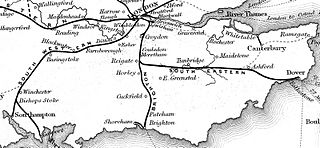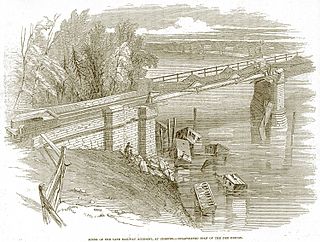Related Research Articles

The London and Brighton Railway (L&BR) was a railway company in England which was incorporated in 1837 and survived until 1846. Its railway ran from a junction with the London & Croydon Railway (L&CR) at Norwood – which gives it access from London Bridge, just south of the River Thames in central London. It ran from Norwood to the South Coast at Brighton, together with a branch to Shoreham-by-Sea.

Foster, Rastrick and Company was one of the pioneering steam locomotive manufacturing companies of England. It was based in Stourbridge, Worcestershire, now West Midlands. James Foster, an ironmaster, and John Urpeth Rastrick, an engineer, became partners in 1816, forming the company in 1819. Rastrick was one of the judges at the Rainhill Trials in 1829. The company was dissolved on 20 June 1831.

The Manchester and Leeds Railway was a British railway company that built a line from Manchester to Normanton where it made a junction with the North Midland Railway, over which it relied on running powers to access Leeds. The line followed the valley of the River Calder for much of the way, making for easier gradients but by-passing many important manufacturing towns. Crossing the watershed between Lancashire and Yorkshire required a long tunnel. The line opened throughout in 1841.
John Urpeth Rastrick was one of the first English steam locomotive builders. In partnership with James Foster, he formed Foster, Rastrick and Company, the locomotive construction company that built the Stourbridge Lion in 1829 for export to the Delaware and Hudson Railroad in America. From the 1830s he concentrated on civil engineering with his major project from 1838 being the construction of the London and Brighton Railway.

The Dee Bridge disaster was a rail accident that occurred on 24 May 1847 in Chester, England, that resulted in five fatalities. It revealed the weakness of cast iron beam bridges reinforced by wrought iron tie bars, and brought criticism of its designer, Robert Stephenson, the son of George Stephenson.
This article lists events relating to rail transport that occurred during the 1780s.
The Bolton and Preston Railway connected Bolton and Preston, in Lancashire, England. Its authorising Act of Parliament forbade its early completion to protect the North Union Railway and imposed other restrictions that limited the success of the B&PR. A change of route was authorised to by-pass the delay making it dependent on the goodwill of the NUR to reach Preston. The NUR saw the B&PR as a competitor and used underhand tactics to harm the success of the B&PR.
References
- ↑ Bairstow, Martin (2004). Railways Through Airedale & Wharfedale. Leeds: Martin Bairstow. ISBN 978-1-871944-28-0.
- ↑ Balkwill, Richard; Marshall, John (1993). The Guinness Book of Railway Facts and Feats (6th ed.). Enfield: Guinness Publishing. ISBN 978-0-85112-707-1.
- ↑ Lewis, Peter R. (2007). Disaster on the Dee: Robert Stephenson's Nemesis of 1847. Stroud: Tempus Publishing. ISBN 978-0-7524-4266-2.
- ↑ BrainyMedia.com (2005). "Rotterdam-Hague Railway opens" . Retrieved 2005-05-27.
- 1 2 Marshall, John (1989). The Guinness Railway Book. Enfield: Guinness Books. ISBN 0-8511-2359-7. OCLC 24175552.
- ↑ Marshall, John (1969). The Lancashire & Yorkshire Railway, vol. 1. Newton Abbot: David & Charles. ISBN 978-0-7153-4352-4.
- ↑ "Daylight Saving Time – Standard time began with the railroads". Archived from the original on 15 September 2005. Retrieved 2005-09-22.
- ↑ Holt, Jeff (1985). The Grand Trunk in New England. Railfare. p. 124. ISBN 0-919130-43-7.
- ↑ Clinker, C. R. Railways of the West Midlands – a chronology, 1808–1954. London: Stephenson Locomotive Society.
- ↑ Bedwell, Carolyn (2002). "John Urpeth Rastrick". Archived from the original on 2005-03-09. Retrieved 2005-04-04.